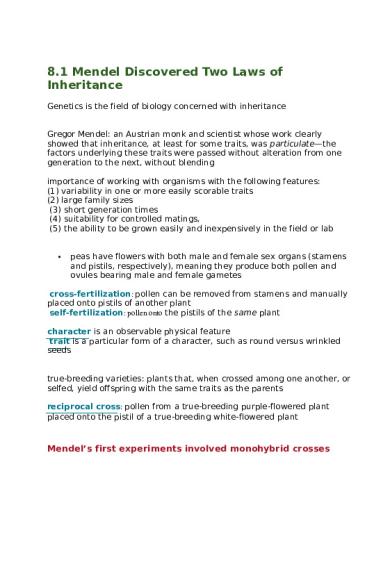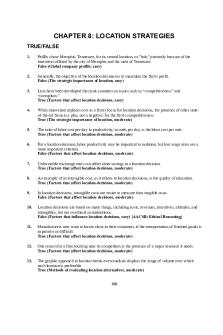Chapter 8 - Summary Principles of Life PDF

| Title | Chapter 8 - Summary Principles of Life |
|---|---|
| Author | Andrew Usachev |
| Course | Foundations of Biology |
| Institution | University of Iowa |
| Pages | 8 |
| File Size | 370.7 KB |
| File Type | |
| Total Downloads | 92 |
| Total Views | 146 |
Summary
(VERY HEAVILY TESTED) Mendel's laws of segregation and independent assortment and detailed summary of chapter 8. super important terminology and details for each term. Introduction to drosophila melanogaster (fruit flies)...
Description
8.1 Mendel Discovered Two Laws of Inheritance Genetics is the field of biology concerned with inheritance Gregor Mendel: an Austrian monk and scientist whose work clearly showed that inheritance, at least for some traits, was particulate—the factors underlying these traits were passed without alteration from one generation to the next, without blending importance of working with organisms with the following features: (1) variability in one or more easily scorable traits (2) large family sizes (3) short generation times (4) suitability for controlled matings, (5) the ability to be grown easily and inexpensively in the field or lab
peas have flowers with both male and female sex organs (stamens and pistils, respectively), meaning they produce both pollen and ovules bearing male and female gametes
cross-fertilization: pollen can be removed from stamens and manually placed onto pistils of another plant self-fertilization: pollen onto the pistils of the same plant character is an observable physical feature trait is a particular form of a character, such as round versus wrinkled seeds
true-breeding varieties: plants that, when crossed among one another, or selfed, yield offspring with the same traits as the parents reciprocal cross: pollen from a true-breeding purple-flowered plant placed onto the pistil of a true-breeding white-flowered plant
Mendel’s first experiments involved monohybrid crosses
Mendel’s monohybrid crosses: crosses of true-breeding parents that differed in a single character such as flower color. He planted the F1 seeds from these crosses and allowed them to self-pollinate to produce the F2 generation Mendel’s observations implied that: (1) the missing trait that was present in the F1, it was just not visible (2) all characters obey the same transmission rule(s) since all seven gave a 3:1 F2 ratio (3) parents contribute equally to offspring, regardless of whether they are the pollen donor or recipient, since reciprocal crosses give the same results allele: different DNA sequences of the same gene Example: There are two alleles for pea flower color: one that determines purple flowers (the purple allele) and another that determines white flowers (the white allele)
genotype: An exact description of the genetic constitution of an individual, either with respect to a single trait or with respect to a larger set of traits phenotype: outward expression of the genotype locus: specific location of a gene on a chromosome homozygous: In diploid organisms, having identical alleles of a given gene on both homologous chromosomes heterozygous: In diploid organisms, having different alleles dominant: the trait that is expressed (observed) in a heterozygous individual recessive: not observed in a heterozygote
Mendel’s first law states that allele pairs segregate equally into gametes law of segregation: when an individual produces gametes, the two alleles of each pair separate equally
This holds true in all meiotic organisms
Mendel tested his hypotheses by performing test crosses test crosses: crossing a plant expressing the dominant phenotype but with an unknown genotype to a recessive homozygous individual addition rule of probability : when two events are mutually exclusive, the probability that either will occur is the sum of the probability of each event multiplication rule of probability : the probability of two independent events occurring at the same time can be obtained by multiplying their individual probabilities
Mendel’s second law states that allele pairs of different genes assort independently law of independent assortment: alleles of different genes assort independently of one another during gamete formation.
Only applies to pairs of genes on different chromosomes
linkage: two genes are located near one another on the same chromosome, their alleles do not assort independently (ratio of 9:3:3:1) The closer genes are on a certain chromosome, the less likely they will cross over Cross over: recombination of genes Recombinant frequency can only go up to 0.5 Recombinant frequency = total number of cross linked off spring / total number of off spring Higher the recombinant frequency, the farther away two genes are because the farther away they are (on the same chromosome), the more likely they will cross over and recombine
8.2 Genes Are Inherited on Chromosomes The behavior of chromosomes during meiosis is consistent with Mendel’s laws
separation of homologs during anaphase I of meiosis results in equal segregation of alleles
Independent assortment is caused by independent alignment of different pairs of homologous chromosomes
Alleles encode different versions of the same protein
Genes determine phenotypes (mostly by encoding proteins with particular functions) dominant allele of a gene is expressed to produce a functional protein recessive allele has been mutated so that it either is no longer expressed or it encodes a protein that is nonfunctional
mutations: rare, stable, and inherited changes in the genetic material, DNA wild type: the allele that is present in most individuals in nature
Not the same as dominant
Sex-linked inheritance is consistent with sex chromosome transmission
females are XX Males are XY
hemizygous: Any gene that is present as a single copy in a diploid organism (Y chromosome) Inheritance of X-linked recessive traits reveals the following patterns: (1) The recessive phenotype appears much more often in males than in females, because only one copy of the allele is needed for its expression in males (2) An affected male passes the mutation to all of his daughters but to none of his sons, who instead get his Y chromosome. (3) Daughters who receive one X-linked mutation are heterozygous carriers
X-linked
dominant characters, they never skip a generation
Genes on the same chromosome can be separated by crossing over in meiosis parental Gametes: the same genotype as the gametes from the individual’s parents that fused to make the double heterozygote recombinant: they differ from the two gametes that fused to make the double heterozygote
recombination frequency: The proportion of offspring of a genetic cross that received gametes that are different from the gametes that fused to make the diploid cell undergoing meiosis due to crossing over between linked genes and independent assortment.
Women are more likely to cross over due to 2 X x chromosomes Max recombinant frequency is 0.5
8.3 Alleles, Genes, and the Environment Interact to Produce Phenotype A single gene can have multiple alleles
multiple alleles can increase the number of possible phenotypes determined by variation at a single gene
incomplete dominance: A condition in which the heterozygous phenotype is intermediate between the two homozygous phenotypes codominance: A condition in which two alleles at a locus produce different phenotypic effects and both effects appear in heterozygotes.
pleiotropic: A single gene can produce a protein that functions in many different parts of an organism epistasis: particular allele of one gene determines how another gene will be expressed How do quantitative traits differ from discrete traits in terms of their underlying genetics?
One way is that quantitative traits are often influenced by many genes—sometimes hundreds or more not all the genes associated with a quantitative trait influence it to the same degree
The environment affects gene action Environmental conditions include: both abiotic factors:
day length temperature humidity oxygen level
biotic factors:
densities of competitors predators parasites
8.4 Conjugation and Transformation Allow Exchange of Genetic Material between Prokaryotes Bacteria transfer plasmid genes by conjugation
plasmids: small circular DNA that replicates independently of the main chromosome lateral gene transfer: transfer of genes from one individual organism to another without sexual (meiotic) reproduction is called (horizontal) vertical gene transfer: gene transfer from parent to offspring
gene transfers between bacteria happen via physical contact between the cells
sex pilus (plural pili) : a thin projection composed of proteins and phospholipids, many of which can extend from a cell (the donor)
Bacteria exchange chromosomal genes by conjugation
This happens when
chromosome
the DNA strand that is transferred is part of the bacterial...
Similar Free PDFs

Twelve Principles of Life
- 1 Pages

Summary Principles of marketing
- 51 Pages

D 3-8 - summary of chapter 8
- 5 Pages
Popular Institutions
- Tinajero National High School - Annex
- Politeknik Caltex Riau
- Yokohama City University
- SGT University
- University of Al-Qadisiyah
- Divine Word College of Vigan
- Techniek College Rotterdam
- Universidade de Santiago
- Universiti Teknologi MARA Cawangan Johor Kampus Pasir Gudang
- Poltekkes Kemenkes Yogyakarta
- Baguio City National High School
- Colegio san marcos
- preparatoria uno
- Centro de Bachillerato Tecnológico Industrial y de Servicios No. 107
- Dalian Maritime University
- Quang Trung Secondary School
- Colegio Tecnológico en Informática
- Corporación Regional de Educación Superior
- Grupo CEDVA
- Dar Al Uloom University
- Centro de Estudios Preuniversitarios de la Universidad Nacional de Ingeniería
- 上智大学
- Aakash International School, Nuna Majara
- San Felipe Neri Catholic School
- Kang Chiao International School - New Taipei City
- Misamis Occidental National High School
- Institución Educativa Escuela Normal Juan Ladrilleros
- Kolehiyo ng Pantukan
- Batanes State College
- Instituto Continental
- Sekolah Menengah Kejuruan Kesehatan Kaltara (Tarakan)
- Colegio de La Inmaculada Concepcion - Cebu












